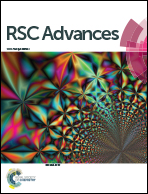CdS nanoparticles anchored on the surface of yeast via a hydrothermal processes for environmental applications
Abstract
Cadmium sulfide (CdS) nanoparticles were successfully anchored on the surface of yeast via a hydrothermal process, forming fructus rubi-like CdS@yeast hybrid microspheres. In this method, the innate functional groups inherited from the hydrophilic cell wall of microbial cells were utilized to anchor the Cd2+ ion, and then the CdS@yeast hybrid particles with fructus rubi-like morphology were obtained in the presence of thioacetamide (TAA) by a hydrothermal treatment process. The products were characterized by scanning electron microscopy (SEM), confocal laser scanning microscopy (CLSM), powder X-ray diffraction (XRD) and UV-Vis diffuse reflectance spectra. The sedimentation performance of CdS@yeast microspheres in aqueous solutions was evaluated to demonstrate the unique features of CdS@yeast in comparison with bulk CdS nanoparticles. The interaction between host core yeast and guests CdS nanoparticles was investigated by Fourier transform infrared (FT-IR) spectroscopy and the possible mechanisms for the formation of CdS@yeast hybrid microspheres were proposed. The model photocatalytic test showed that the fructus rubi-like CdS@yeast microsphere could efficiently remove methylene blue (MB) dyes from aqueous solutions due to the combined functions from the bio-sorption of the yeast core and photocatalytic degradation driven by the attached CdS nanoparticles. The present approach represents a guide for the preparation of a variety of hybrid composites with similar structure for treatment of toxic organic pollutants.


 Please wait while we load your content...
Please wait while we load your content...